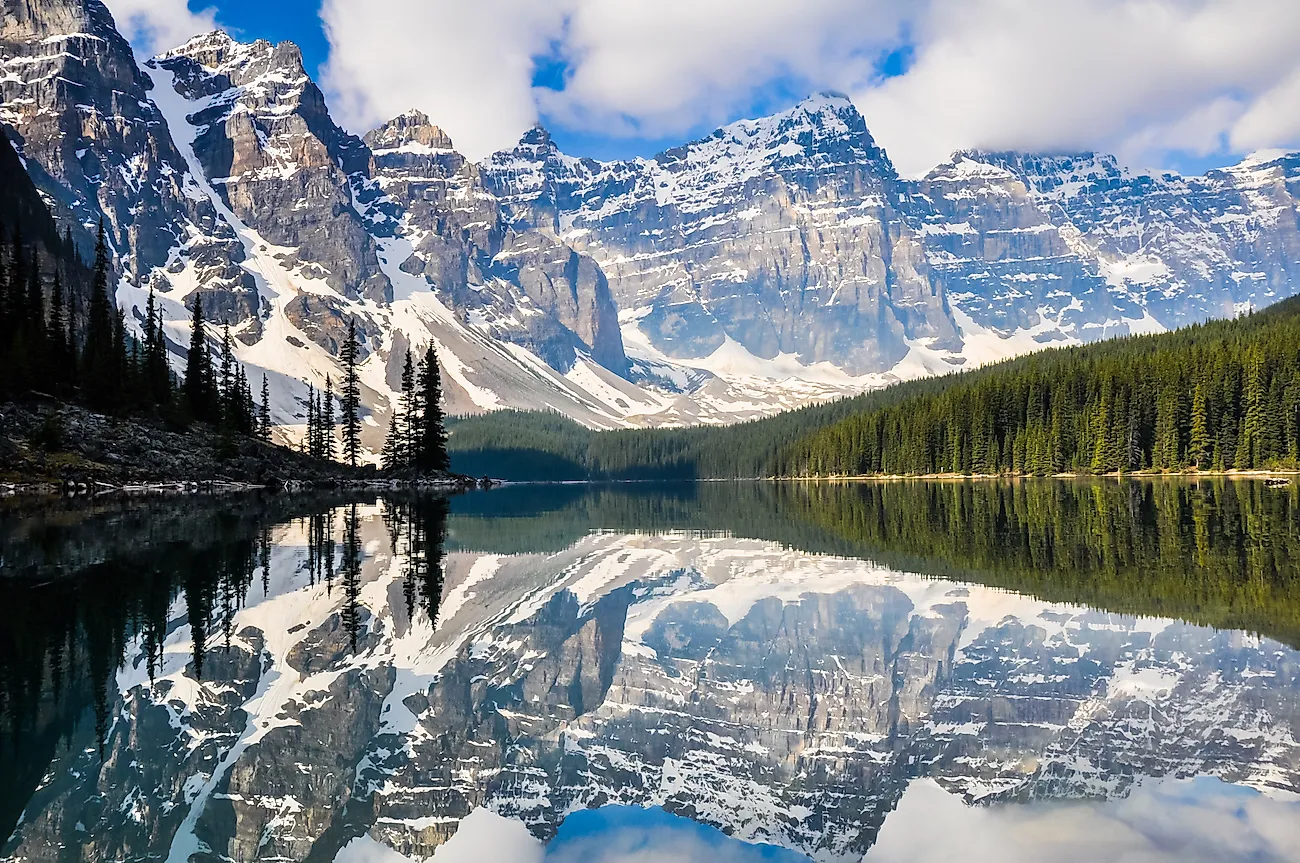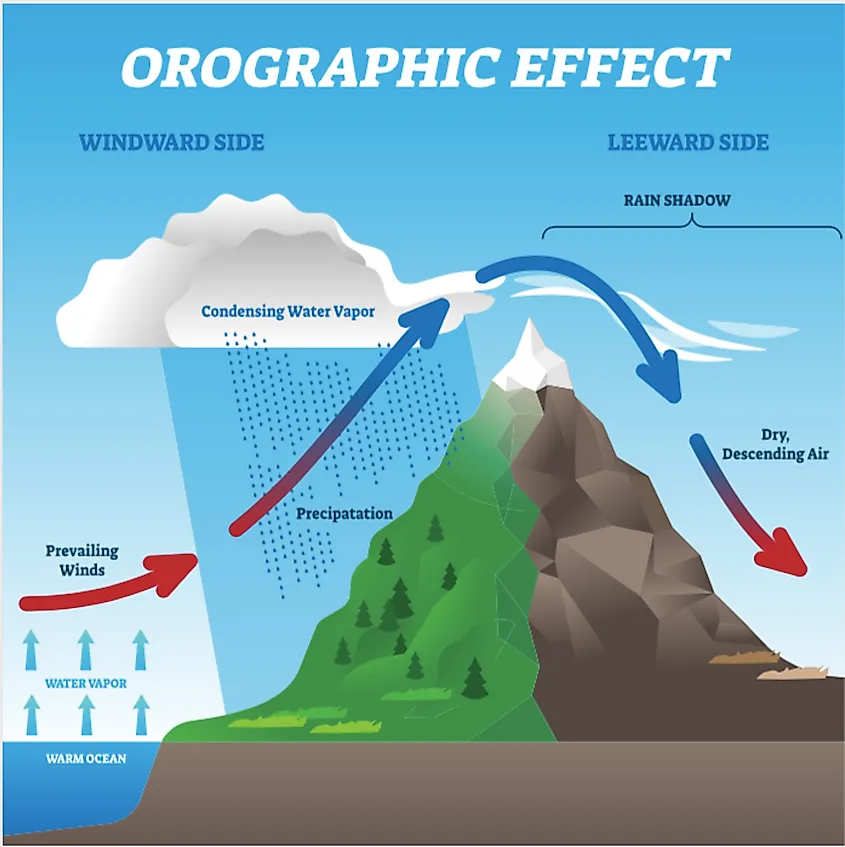How Do The Rocky Mountains Influence Climate?

- The Rocky Mountains are 76 million years old.
- The highest peak of the Rocky Mountains is Mount Elbert in Colorado at 14,440 feet.
- Most of the Rocky Mountain range is protected under National Park status.
Majestic and well-known for their ski hills, hiking trails, campgrounds, and fishing opportunities, the Rocky Mountains, some with peaks of over 14,000 feet, have a profound impact on weather patterns and geography in North America.
From the Canadian Rockies, which begin in northern British Columbia, Canada, to its most southern point in New Mexico, the Rocky Mountains form a barrier between the Pacific Ocean and inland provinces and states, significantly influencing weather and creating areas of dense forest and lush greenery as well as desert-like conditions. Their size and locale also play an integral role in the formation of the famed snow-eater Chinook winds, which pass over the plains and prairies during winter months, bringing a rush of warm weather and melting snow packs in their wake.
The mountain range plays an integral role in the climate of Canada and the United States, and not just in their local western-North American region. Though located in states like Colorado, Nebraska, Kansas, New Mexico, South Dakota and Wyoming, the effects of the mountain range can be felt in their immediate vicinity, as well as around the world.
Rain Shadow

The Rocky Mountains cast a fairly substantial rain shadow - a dry area on the leeward side of the mountain range, where wind does not hit, which forms because the mountains block rain-producing weather systems and create a metaphorical shadow of dryness. Wet weather systems begin on the Pacific Ocean and travel over the western states to the Rocky Mountains, and as the air moves higher up the western slope it cools and condenses, leaving rain and snow along the mountainside in its wake. Having been stripped of moisture, the air continues over the Rocky Mountains and dries out as it moves down the eastern slope. Because the air is now dry, it absorbs moisture from the landscape, leaving the earth more arid.
Essentially, the rain shadow is a desert forced into existence because of the mountain range it borders, which prevents the eastern slopes and foothills from experiencing the same moisture that falls on the western side of the range.
While some claim the mountain range is responsible for creating the southwestern desert areas of the United States, the matter is up for debate as others claim the precipitation-bearing systems are blocked by Californian mountain ranges and never reach the Rockies in the first place. However, all researchers agree the rain shadow cast by the Rocky Mountains is significant.
Chinook Winds
Chinook winds are streams of strong, dry, warm air that cascade over the Rocky Mountains, melting snow and ice in their wake during the cold winter months on the plains. They bring about sharp temperature changes.
The winds are named for the Chinook tribe of Native Americas, who lived in the coastal regions of Washington and Oregon near the Columbia River.
A Chinook forms when warm, moist air comes in from the Pacific Ocean in the northwest region of the Rocky Mountain range and cools as it climbs the mountain to bring rain or snow to its peaks. Once moisture has been released in the mountains, the winds are drier as they move down the eastern slopes and warm rapidly to temperatures higher than the winds that came off the Pacific Ocean originally, as much as 50 degrees Fahrenheit warmer than the air they displace as they travel across the land. When winds suddenly change direction toward the west or southwest, Chinook winds pick up with rapidly rising speeds and wind gusts can be measured as high as 80 mph.
The effect of fast-moving warm winds on snow is remarkable, with a foot of snow sometimes disappearing within hours.
Some claim Chinook winds cause migraines, increased cases of sudden infant death syndrome, and strokes, but evidence to prove their effect on health is largely considered anecdotal and research continues to determine whether there is a direct correlation between human physiology and the Chinook wind.
Air Masses
Based on climate models, researchers have determined the impact the Rocky Mountains have on the world by removing them in simulation programs to see the effects. The Rocky Mountains force enormous air masses from the west in a more southward direction, where they absorb heat and moisture before continuing to the east. Moving the air in this direction creates dominant warm, moist southwesterly winds in places like Norway, keeping the country's average temperatures above freezing, and between 5 degrees Celsius to 10 degrees Celsius warmer than other countries along the same latitude.
The discovery was made by researchers at Bjerknes Centre for Climate Research in Bergen, Norway, who claim that while the Gulf Stream and the Norwegian Sea both impact the climate of the nordic country, the simulated removal of the North American Rocky Mountains proved the range plays a noteworthy role in bringing warmer air to the Norse.











